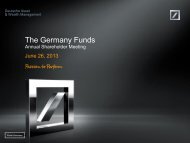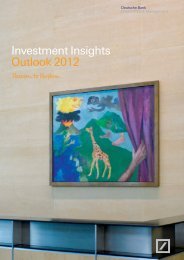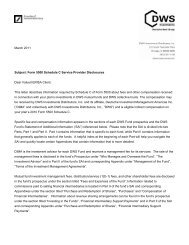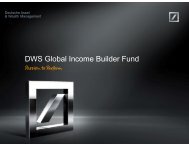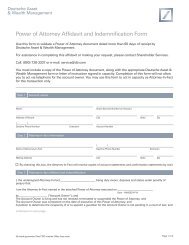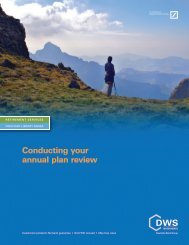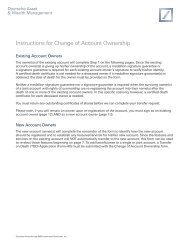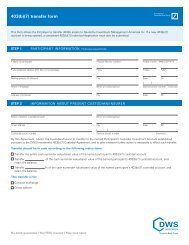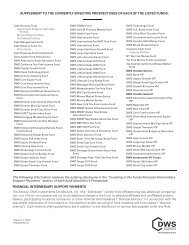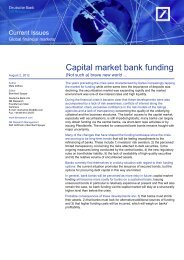Brochure DWS RREEF Global Infrastructure Fund - DWS Investments
Brochure DWS RREEF Global Infrastructure Fund - DWS Investments
Brochure DWS RREEF Global Infrastructure Fund - DWS Investments
- No tags were found...
You also want an ePaper? Increase the reach of your titles
YUMPU automatically turns print PDFs into web optimized ePapers that Google loves.
Pure-play investing at workNot all infrastructure is created equal. Focusing on the pure-play portion of the infrastructure universeallows <strong>DWS</strong> <strong>RREEF</strong> <strong>Global</strong> <strong>Infrastructure</strong> <strong>Fund</strong> to replicate the investment characteristics of the asset class.Many infrastructure-related companies have different business models and characteristics. The fund selectsspecific portions of the universe on which to focus. Within the energy sector, for example, the fund focuseson the mid-stream portion of the value chain, which exhibits the natural characteristics of infrastructure asan asset class.The energy value chainUpstream Midstream DownstreamExploration andproductionStorage andtransportationMarketing and supplyDescriptionDiscovery andproduction of oil andnatural gasTransportation of gasoil via small-or largediameterpipes overvarious distance;storage of excesscapacityPurchasing of refinedoil and gas for deliveryto end usersCharacteristicsDominated by energycompany majors;economic fundamentalsare highly dependentupon commodity pricesMonopolistic in nature,stable revenues; arenot highly correlated tounderlying commoditypricesHighly competitive,typically lower-marginbusinessCompany examplesExxon, Conoco,Chesapeake EnergyEnbridge, TranscanadaValeroRegulation Minimal Regulated Less regulated<strong>DWS</strong> <strong>RREEF</strong> <strong>Global</strong> <strong>Infrastructure</strong> <strong>Fund</strong> focuses on the midstream portionof the value chain.As of 2/28/14, <strong>DWS</strong> <strong>RREEF</strong> <strong>Global</strong> <strong>Infrastructure</strong> <strong>Fund</strong> held the following percentages in the securities mentioned: ChesapeakeEnergy, 0%; Exxon, 0%; Conoco, 0%; Enbridge, 3.4%; Transcanada, 5.2%; Valero, 0.9%. Securities referenced do not represent all ofthe securities purchased or sold by the fund, may or may not be profitable, and should not be construed as a recommendation of anyspecific security. Current and future portfolio holdings are subject to risk.4 <strong>DWS</strong> <strong>RREEF</strong> <strong>Global</strong> <strong>Infrastructure</strong> <strong>Fund</strong>
Why consider infrastructure as an asset class?<strong>Infrastructure</strong> as an asset class offers many important characteristics:——monopolistic qualities;——services of an essential nature to society;——a potential hedge against rising inflation (since hard assets tend to retain their values); and——stable, predictable cash flows.Indeed, infrastructure cash flows have been resilient. <strong>Infrastructure</strong> securities’ history of relativelypredictable cash flows and high dividend yields demonstrate their underlying defensiveness. Listedinfrastructure has shown positive EBITDA (earnings before interest, taxes, depreciation and amortization)growth for more than a decade, including two recessionary periods. <strong>Global</strong> equities have not shown thissame resilience, and in fact have shown negative growth during certain calendar years.Annual EBITDA growth (local currency)–12.3%–16.2%–0.5%6.9%0.9%14.2%14.6%11.0%19.3%14.7%6.6%19.5%6.7%21.5%10.4%11.3%5.1%13.3%9.65%13.37%3.08%6.02%2002 2003 2004 2005 2006 2007 2008 2009 2010 2011 2012<strong>Global</strong> equities<strong>Global</strong> infrastructure equitiesSource: MSCI, Reuters, Bloomberg, Dow Jones and JP Morgan Quantitative Strategy as of 12/31/12 (the latest data available). <strong>Global</strong>equities are represented by the MSCI World Index. <strong>Global</strong> infrastructure equities are represented by the Dow Jones-Brookfield <strong>Global</strong><strong>Infrastructure</strong> Index. Shaded bar indicates a recession, which took place from December 2007 to June 2009. Index returns assumereinvestment of all distributions and do not reflect fees or expenses. It is not possible to invest directly in an index. See back page forindex definitions.Fast factEBITDA—which is essentially net income with interest, taxes, depreciation and amortization added backto it—is an indicator of financial performance. It is used to compare profitability between companies andindustries because it eliminates the effects of financing and accounting decisions.<strong>DWS</strong> <strong>RREEF</strong> <strong>Global</strong> <strong>Infrastructure</strong> <strong>Fund</strong> 5
<strong>DWS</strong> <strong>RREEF</strong> <strong>Global</strong> <strong>Infrastructure</strong> <strong>Fund</strong>:compelling upside/downside captureThe characteristics of the infrastructure asset class—specifically the pure-play approach—have helped<strong>DWS</strong> <strong>RREEF</strong> <strong>Global</strong> <strong>Infrastructure</strong> <strong>Fund</strong> deliver differentiated investment characteristics. The companies inwhich the fund invests tend not to be as tied to and dependent upon overall economic cycles. This can bedemonstrated by the superior upside/downside capture ratios of the fund vs. the S&P 500 Index andMSCI World Index.Solid upside capture with dramatically better downside capture (three years as of 3/31/14)71.30%71.52%25.44%16.15%<strong>Fund</strong> vs. S&P 500 Index<strong>Fund</strong> vs. MSCI World IndexUpside captureDownside captureSource: Morningstar as of 3/31/14. Past performance is historical and does not guarantee future results. The values of equityinvestments are more volatile than those of other securities. Fixed-income investments are subject to interest-rate risk, and theirvalues will decline as interest rates rise. Commodities and real estate should be considered part of a diversified portfolio; marketpricemovements, regulatory changes, economic changes and adverse political or financial factors could have a significant impact onperformance. See back page for definitions.Fast factUpside capture ratio measures a portfolio’s performance in up markets relative to the investment universe(with up markets defined as those that have a positive monthly return). The higher the upside capture ratio,the better the portfolio performed during a market upturn. Downside capture ratio measures a portfolio’sperformance in down markets relative to the investment universe (with down markets defined as those thathave a negative monthly return). The lower the downside capture ratio, the better the portfolio performedduring a market downturn.6 <strong>DWS</strong> <strong>RREEF</strong> <strong>Global</strong> <strong>Infrastructure</strong> <strong>Fund</strong>
<strong>DWS</strong> <strong>RREEF</strong> <strong>Global</strong> <strong>Infrastructure</strong> <strong>Fund</strong>:strong historical return and low volatilityThe pure-play infrastructure characteristics we have discussed—along with a talented portfoliomanagement team—have helped <strong>DWS</strong> <strong>RREEF</strong> <strong>Global</strong> <strong>Infrastructure</strong> <strong>Fund</strong> deliver compelling investmentperformance, including attractive returns and lower volatility compared to the broad equity universe.Strong returns21.54%21.16%16.34%14.66%18.28%10.23%3-year<strong>DWS</strong> <strong>RREEF</strong> <strong>Global</strong> <strong>Infrastructure</strong> <strong>Fund</strong>MSCI World Index5-yearS&P 500 IndexLow volatility14.06%12.47%11.89%15.77%13.99%9.09%3-year5-year<strong>DWS</strong> <strong>RREEF</strong> <strong>Global</strong> <strong>Infrastructure</strong> <strong>Fund</strong>MSCI World IndexS&P 500 IndexSource: Morningstar and Bloomberg as of 3/31/14. Performance is historical and does not guarantee future results. Investmentreturn and principal fluctuate so your shares may be worth more or less when redeemed. Current performance may differ fromdata shown. Please visit www.dws-investments.com for the fund’s most recent month-end performance. Performance is for ClassA shares, unadjusted for sales charges. Unadjusted returns do not reflect sales charges and would be lower if they did. The fundmay charge a 2% fee for redemptions within 15 days. Performance includes reinvestment of all distributions. Volatility is representedby standard deviation. Index returns assume reinvestment of all distributions and do not reflect fees or expenses. It is not possible toinvest directly in an index. See page 10 for standardized performance information and expense ratios. See back page for definitions.<strong>DWS</strong> <strong>RREEF</strong> <strong>Global</strong> <strong>Infrastructure</strong> <strong>Fund</strong> 7
The potential benefits of adding infrastructureassets to a portfolioWe believe infrastructure should be considered as part of a well diversified portfolio based on its uniqueinvestment characteristics. Adding infrastructure to a traditional portfolio of stocks and bonds can potentiallyimprove returns while lowering volatility, thus improving risk-adjusted returns.Traditional diversified portfolio5-yearReturn 14.54%Volatility 9.12%Sharpe ratio 1.53Cash 5%Bonds 33%International stocks 10%Small-cap stocks 8%Large-cap stocks 44%Diversified portfolio with infrastructure5-yearReturn 14.98%Volatility 8.65%Sharpe ratio 1.65Cash 4%<strong>Infrastructure</strong> 10%Bonds 33%International stocks 5%Small-cap stocks 6%Large-cap stocks 42%Source: Morningstar of 3/31/14. Performance is historical and does not guarantee future results. Data for the traditional portfoliofor the one- and three-year periods is as follows: return, 13.03%/9.64%; volatility, 6.63%/8.12%; Sharpe ratio, 1.88/1.17. Data forthe portfolio with infrastructure for the one- and three- period is as follows: return, 12.53%/10.15%; volatility, 6.57%/7.58%; Sharperatio, 1.83/1.31. Asset-class representation is as follows: bonds, Barclays U.S. Aggregate Index; cash, Citigroup 3-Month TreasuryBill Index; infrastructure, Dow Jones-Brookfield <strong>Global</strong> <strong>Infrastructure</strong> Index; international stocks, MSCI EAFE Index; large-cap stocks,S&P 500 Index; small-cap stocks, Russell 2000 Index. Index returns assume reinvestment of all distributions and do not reflect fees orexpenses. It is not possible to invest directly in an index. Volatility is represented by standard deviation. See page 10 for standardizedperformance information and expense ratios. See back page for definitions.Where does infrastructure fit in a portfolio?<strong>Infrastructure</strong> securities can offer investors various diversification benefits. Most investor portfolio aredominated by traditional equities (for capital appreciation) and bonds (for low volatility and yield). Thinkof infrastructure securities as a hybrid investment: an equity security with bond-like characteristics that isbacked by real assets. <strong>Infrastructure</strong> can be used as an equities diversifier—or as part of an alternative realreturnallocation—similar to commodities and real estate.<strong>DWS</strong> <strong>RREEF</strong> <strong>Global</strong> <strong>Infrastructure</strong> <strong>Fund</strong> 9
A prominent infrastructure securities managerThe Deutsche Asset & Wealth Management alternatives platform offers access to broad resourcesincluding a direct infrastructure business (which has $11.5 billion in direct infrastructure assets) as of12/31/13 and real estate securities business (which has $8.8 billion in assets under management)as of 12/31/13.Deutsche Asset & Wealth Management is an asset leader——Has $10.6 billion in listed infrastructure security assets under management as of 12/31/13——Has 19 direct infrastructure assets under management valued at $11.5 billion as of 12/31/13——Has made 44 acquisitions since 1994 as of 12/31/13Deutsche Asset & Wealth Management is a thought leader——Uses a systematic valuation methodology that adapts to different infrastructure and market conditions——Uses a robust analytical framework that combines in-depth due diligence and proprietaryfinancial modelling——Utilizes a “pure-play” focus that seeks to best replicate investment characteristics of the infrastructureasset class in order to provide superior risk-adjusted returns relative to other asset classesDeutsche Asset & Wealth Management real estate and infrastructure team locationsLondonWestborough Luxembourg WarsawSeattle ChicagoParis FrankfurtSan FranciscoCosta MesaNew YorkZurichMadrid MilanGlen Carbon BethesdaDallas AtlantaTokyoSeoulShanghaiHong KongSingaporeSydneySource: Deutsche Asset & Wealth Management as of 12/31/13. AUM represents the gross asset value (including leverage) of assetsmanaged for third parties and the net asset value (excluding leverage) of proprietary positions. It excludes assets managed by theAustralian team (HVP Plantations, Matariki Forests, Ulan Coal, Kestrel Coal and Crinum). Deutsche Asset & Wealth Managament hasalso made principal investments in infrastructure assets, the management of which has subsequently been transferred to other areasof Deutsche Bank. Northern Gas Networks (NGN) is included in the Australian AUM as NGN is managed by the Australian team.<strong>DWS</strong> <strong>RREEF</strong> <strong>Global</strong> <strong>Infrastructure</strong> <strong>Fund</strong> 11
Nasdaq symbols A C INST S<strong>DWS</strong> <strong>RREEF</strong> <strong>Global</strong> <strong>Infrastructure</strong> <strong>Fund</strong> TOLLX TOLCX TOLIX TOLSXDefinitionsThe Barclays U.S. Aggregate Index tracks the performance of the broad U.S. investment-grade, fixed-rate bond market, includingboth government and corporate bonds. The Citigroup 3-Month Treasury Bill Index tracks the performance of U.S. Treasury obligationswith maturities of three months. The Dow Jones-Brookfield <strong>Global</strong> <strong>Infrastructure</strong> Index tracks the performance of companies in theinfrastructure business. The MSCI EAFE Index tracks the performance of stocks in select developed markets outside of the United States.The MSCI World Index tracks the performance of stocks in select developed markets around the world, including the United States.The Russell 2000 Index tracks the performance of the 2,000 smallest stocks in the Russell 3000 Index. The S&P 500 Index tracks theperformance of 500 leading U.S. stocks and is widely considered representative of the U.S. equity market. Equity index returns includereinvestment of all distributions. Index returns do not reflect fees or expenses and it is not possible to invest directly in an index.Term definitionsBeta measures a security’s sensitivity to the movements of the fund’s benchmark or the market as a whole. A beta of greater thanone indicates more volatility than the benchmark or market, while a beta of less than one indicates less volatility. Sharpe ratiomeasures an investment’s performance per unit of risk for a given period. Standard deviation is often used to represent the volatilityof an investment. It depicts how widely an investment’s returns vary from the investment’s average return over a certain period.Upside/downside capture ratio measures a portfolio’s performance in up/down markets relative to the investment universe (with up/down markets defined as those that have a positive/negative monthly return); the higher/lower the upside/downside capture ratio, thebetter the portfolio performed during a market upturn/downturn.Important risk informationAny fund that concentrates in a particular segment of the market will generally be more volatile than a fundthat invests more broadly. Investing in foreign securities, particularly those of emerging markets, presentscertain risks, such as currency fluctuations, political and economic changes, and market risks. This fundis non-diversified and can take larger positions in fewer issues, increasing its potential risk. Stocks maydecline in value. The fund may lend securities to approved institutions. Stocks may decline in value. See theprospectus for details.Obtain a prospectusTo obtain a summary prospectus, if available, or prospectus, download one from dws-investments.com,talk to your financial representative or call (800) 728-3337. We advise you to carefully consider theproduct’s objectives, risks, charges and expenses before investing. The summary prospectus andprospectus contain this and other important information about the investment product. Please read theprospectus carefully before you invest. All investments involve risk, including potential loss of principal.Investment products: No bank guarantee | Not FDIC insured | May lose valueInvestment products offered through <strong>DWS</strong> <strong>Investments</strong> Distributors, Inc. Advisory services offered throughDeutsche Investment Management Americas, Inc.Deutsche Asset & Wealth Management represents the asset management and wealth managementactivities conducted by Deutsche Bank AG or any of its subsidiaries. Clients will be provided Deutsche Asset& Wealth Management products or services by one or more legal entities that will be identified to clientspursuant to the contracts, agreements, offering materials or other documentation relevant to such productsor services.<strong>DWS</strong> <strong>Investments</strong> Distributors, Inc.222 South Riverside Plaza Chicago, IL 60606-5808www.dws-investments.com service@db.comTel (800) 621-1148© 2014 Deutsche Bank AG. All rights reserved. PM145459 (4/14) R-28357-2 DRGIF-600



